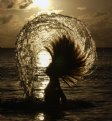
Gayle's Eclectic Photos
(K=91109) - Comment Date 11/26/2006
|
hi,Mark.....found the following via google
"the book "How to Photograph Works of Art" by Sheldan Collins available thru Amazon.com"
hope it helps...regards,gayle
|
|
|
|

Fadel J
(K=13974) - Comment Date 11/26/2006
|
Is there a chance the problem might be with the exposure? it looks like the scene was bright enough for the camera to underexpose it. If that's the case I suggest you point the camera to the wall (it looks like middle grey) and lock the exposure (AE lock button) then recompose and take the shot.
|
|
|
|

Phillip Cohen
 (K=10561) - Comment Date 11/27/2006
(K=10561) - Comment Date 11/27/2006
|
Mark,
A few things, first do not mix flash and tungsten lighting for applications like this. First the flash is or should be much brighter then the 500w lights. It should be several stops brighter so you will not gain anything using the hot lights. Next the color temperature of your flash is approximately 5500 degrees, so it does not match the incandescent lights you are using. If you are going to use only the hot lights. Place them at 45 degrees to the painting, place a difuser between the light and the painting so that the light is spread over a larger area and not a point source. You can use some white ripstop nylon and a frame made of wood or PVC pipe if you don't have a real diffusion panel.
Next shoot a grey card and use your camera to measure the color temp to give you back the correct color. If you choose not to do this, set your camera to a fixed white balance, do not set it to auto. Do not change the white balance during the shoot once you have selected a preset. After the shoot you can find the correct color correction formula and apply it to all of the images in photoshop to adjust them to the proper temperature.
The picture you show in the attachment is underexposed by at least a stop so I would meter the painting and properly adjust your camera. You can try braketing in half stop increments to try and zero in the exposure.
If you are shooting the picture through glass in the frame, you will get a stop or more loss of light going through the glass sheet depending upon the type of glass it is. So if you are measuring with a meter at the glass, you will most likely have to increase the exposure by at least one stop to properly expose the image behind the glass. I would not use the reflective meter in the camera for this, I would use an incident meter and place it at the painting to measure the light falling on the painting. This will give you the most accurate exposure unrelated to the color of the image.
Shooting images like this is not hard, just takes a little practice to get the color temp dialed in and make sure you have proper exposure.
Phil
|
|
|
|

Mark Kirchner
(K=1224) - Comment Date 11/27/2006
|
Phillip,
Thanks very much for taking the time to respond to my post and educate me in this area.It does take a bit of work to dial things in while first learning about good indoor lighting. Regards!
|
|
|
|

Mark Kirchner
(K=1224) - Comment Date 11/27/2006
|
Thanks Fadel! Looks like everyone is getting me on track.
|
|
|
|
















